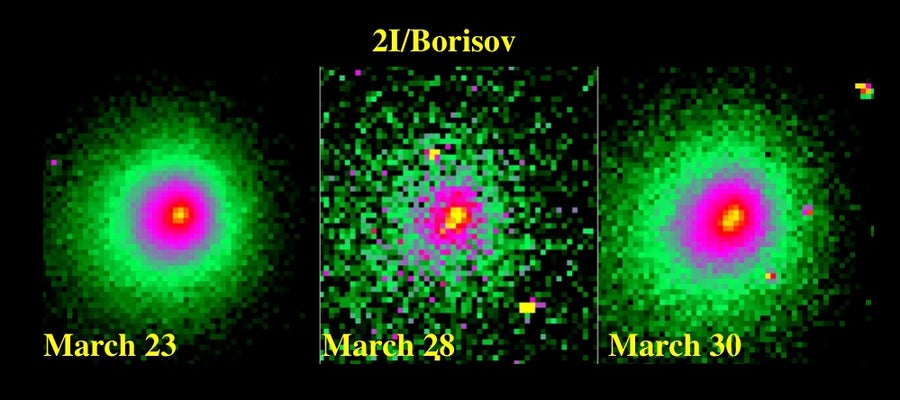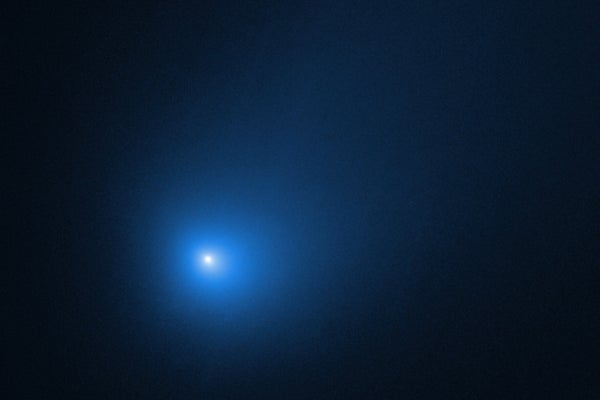About four months ago, in December 2019, the interstellar comet known as 2I/Borisov made its closest approach to our sun. After its initial discovery by Crimean amateur astronomer Gennady Borisov in August 2019, astronomers raced to observe the object—only the second known visitor from another star since the asteroidlike ‘Oumuamua in 2017—before it drifted out of view. But aside from merely watching 2I/Borisov, they were hoping for something else: that the warmth of our sun would crack the comet apart, releasing material from its innards that was scarcely, if at all, altered after forming billions of years ago in an alien star system.
In late March those hopes were fulfilled. Observations from two teams of astronomers using the Hubble Space Telescope have confirmed that a large chunk of debris up to 100 meters in size has broken off from the comet’s solid icy core, known as the nucleus, which is itself up to 500 meters across. This fragment was moving away from the comet at about 0.5 meter per second and was seen more than 180 kilometers from its nucleus. “A small fragment of the primary nucleus has come off,” says David Jewitt of the University of California, Los Angeles, who leads one of the teams. “Something came out.” Later images from Hubble revealed the fragment has since disintegrated—but the comet could well continue to cast off debris.
Ever since 2I/Borisov, often referred to as Comet Borisov, was discovered, astronomers have been eagerly studying its reflected light, using a process called spectroscopy to discover its composition and compare it to more familiar homegrown objects in our solar system. They have detected traces of water, cyanide, oxygen, and more. Those findings could be but a prelude, though, to the treasure trove of data from observations of Borisov as it breaks apart. “Cracking it open is even more exciting, because what we’re really interested in is what this thing’s made of,” says Dennis Bodewits of Auburn University, who is part of the other Hubble team. “If you crack [it] open, you get material that’s never been heated before, the building blocks of another solar system.”
On supporting science journalism
If you're enjoying this article, consider supporting our award-winning journalism by subscribing. By purchasing a subscription you are helping to ensure the future of impactful stories about the discoveries and ideas shaping our world today.
Borisov made its closest approach to the sun on December 8, 2019, reaching about twice the Earth-sun distance. While the origin of the object is not known, this event may have been the first time it has ever been significantly heated by a star, a process that causes ices to boil off comets as gases, lending them their distinctive tail. It was not until early March, however, that Borisov showed any signs of responding to this heating when it let out multiple outbursts of material.

Hubble images of interstellar comet 2I/Borisov reveal the object breaking apart as it drifts away from the sun. Credit: NASA, ESA and D. Jewitt
These outbursts may have increased the comet’s rotation speed, resulting in the subsequent fragmentation that has now been observed. “If the nucleus spins itself up because of these outgassing torques, it can spin so fast that it basically flies apart,” Jewitt says. “We can calculate the gravitational escape speed for this nucleus, and we can guess the density to be like other comets. The test of that will come in the future—if we ever get to see the nucleus without dust around it.”
As to why it took the comet until now to fragment, Michele Bannister of the University of Canterbury in New Zealand says she was a “little surprised,” considering the closest approach to the sun was four months ago. She notes, however, that Borisov’s high speed, as compared with the sun, may have played a part, swooping the object past our star much faster than native comets and thus subjecting it to less overall heating. “You do have to shift your expectations a bit relative to the solar system stuff,” Bannister says.
Hubble alone will be able to tell us a great deal about this event and any subsequent activity from Borisov. Yet astronomers have lamented the unfortunate timing of this never before seen breakup happening now, when most of the world’s major observatories are shuttered because of the coronavirus pandemic. “The comet is now only visible in the southern hemisphere. And all major facilities in the Southern Hemisphere—from Chile to Australia to South Africa—are closed,” says Quanzhi Ye of the University of Maryland.
Bannister notes she and her colleagues would normally now be measuring the composition of the interior in earnest with instruments such as the Very Large Telescope in Chile—observations that, for now, are simply not possible. “Hubble is a beautiful thing, but it has a bunch of different tools that are specialized to very particular purposes,” she says. “I’m not sure that [Borisov’s] going to be bright enough in some of the parts of the spectrum [for which] we have the available instrumentation on Hubble. What we can measure about the composition will be substantially limited.”
Although Borisov will remain visible to Hubble for up to another year, ground telescopes will only have a couple of months before it becomes too faint to study. Whether the pandemic’s grip on the globe will have loosened by then is unclear, but for the time being, the grand finale of one of our solar system’s most extraordinary events is airing without a full house.
